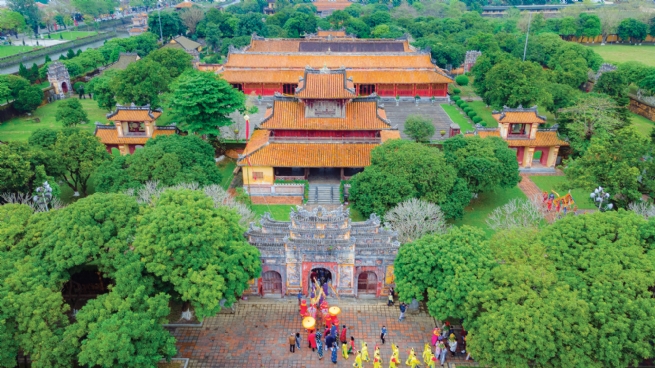Widening Doorway for Vietnam-U.S. Tourism Cooperation
The elevation of Vietnam-United States relations to a “Comprehensive Strategic Partnership” has laid a solid foundation for advancing bilateral cooperation across various fields, including tourism. Tourism cooperation between the two countries keeps thriving, with the U.S. becoming one of Vietnam’s key source markets, showing impressive growth in both visitor arrivals and spending.

Hue - a world cultural heritage city - is a favored tourist destination
Attracting U.S. tourists with unique charms
In 2024, Vietnam welcomed nearly 780,000 American visitors, more than four times the number in 2022 and higher than the pre-pandemic figure (around 746,000 visitors in 2019). In just the first five months of 2025, more than 375,000 American tourists visited Vietnam, accounting for a significant share of total international arrivals.
In addition to the growing number of tourists, American visitors to Vietnam have high spending levels. According to the Vietnam National Authority of Tourism (VNAT), each American visitor spends an average of US$1,570 to US$1,710 per trip, significantly above the international average. Many are willing to spend US$400 to US$1,000 per day for premium experiences such as cruises in Ha Long Bay, luxury resorts on Phu Quoc Island or unique sports and nature exploration tours. This group of tourists have high demand for service quality, long stays and diverse experiences.

The Statue of Liberty - one of the most famous landmarks in New York
Mr. Phung Tuan, Director of Vietmy Discovery, said that Vietnam appeals to American tourists through distinctive factors that differentiate it from other global destinations. Its rich cuisine, heroic history, friendly and hospitable people, and outstanding destinations like Ha Noi, Ho Chi Minh City, Hoi An, Phu Quoc and Sa Pa are highly rated by American tourists for safety, distinctiveness and affordability. Notably, many U.S. visitors are excited about authentic rural experiences such as plowing fields, weaving baskets or doing traditional cooking, thus fostering a deep connection with local life.
Based on statistics and actual experiences, Vietnam sees U.S. visitors as a highly potential demographic in terms of income and foreign currency inflow and as a golden opportunity to increase the added value across the national tourism supply chain. This also reflects the sustainable development of Vietnam’s tourism sector amid deep international integration.
Mr. Ha Van Sieu, Vice Chairman of the Vietnam National Authority of Tourism (VNAT), stated: “American tourists are a key target group that the Vietnamese tourism sector aims for in its international market development strategy. They spend much, demand high-quality services and tend to stay longer, contributing considerably to increasing the added value of the tourism sector.”
Vision for sustainable development
Vietnam-U.S. tourism cooperation is benefiting from multiple favorable internal and external factors. First, the political relationship between the two countries is warm, trusting and expanding across sectors, laying a solid foundation for economic and cultural cooperation, including tourism. Second, direct flights between the two countries operated by Vietnam Airlines, Bamboo Airways and Vietjet Air shorten travel time and improve convenience, boosting tourism demand.
Third, U.S. travelers are known for high spending, seeking immersive experiences, and showing a strong interest in culture, nature and local lifestyles. Statistics show that the number of U.S. visitors to Vietnam grows by 16-20% annually, with projections suggesting 900,000 to 1 million visitors in 2025. This highly promising figure opens new opportunities for Vietnam’s tourism industry.

Mu Cang Chai, nestled in the northwest of Vietnam, boasts a breathtaking landscape of golden rice terraces
Mr. Pham Tien Dung, Director of GoldenTour Travel Company, said: “American tourists are especially keen on personalized experiences, such as wellness retreats combined with local cultural discovery. Vietnam can serve this market well if it has the right investments and develops appropriate products.”
Vietnam still maintains a competitive advantage in terms of value for money in the eyes of international visitors, especially Americans - who seek high-quality, safe and unique experiences in a culturally distinctive environment. This provides a strong premise for Vietnam’s tourism sector to continue growing and elevate its standing on the global tourism map.
In the national tourism development strategy to 2030, with a vision to 2045 proposed by the Ministry of Culture, Sports and Tourism, the U.S. is seen as one of the 10 most important international markets. Vietnam aims to attract 1.5-2 million American visitors annually by 2030, raising the share of tourism in national economic growth.
On policy, Vietnam is reviewing proposals to offer short-term visa exemptions for U.S. citizens and expand flexible e-visa options to create more favorable conditions for travelers. Minister of Culture, Sports and Tourism Nguyen Van Hung emphasized: “The U.S. is a strategic market that requires liberal visa policies along with distinctive tourism products tailored to American travelers’ preferences and needs.”
Vietnam aims to host annual Vietnam Tourism Weeks in the U.S. and strengthen cooperation with major partners such as Brand USA, Google and Expedia to enhance promotional effectiveness. In addition, Vietnamese tourism businesses are encouraged to collaborate closely with U.S. partners to develop attractive products and engage the Vietnamese diaspora of over 2 million people in the U.S. as a bridge for promoting and spreading Vietnamese culture and tourism.
Currently, Vietnam’s tourism sector is investing more in personalized, high-end, wellness, MICE (meetings, incentives, conferences and exhibitions), cruise and luxury vacation property. Quang Ninh, Khanh Hoa, Ho Chi Minh City, Da Nang and other localities conduct active promotion in the U.S. market through direct connection events and programs in the U.S., aiming to build a professional and effective destination brand.
Successful leveraging the strategic relationship, improving visa policies, enhancing service quality and intensifying market promotion will enable Vietnam to become a top destination for American tourists in Asia. This is not only a sectoral strategy but also a national commitment in the integration journey and sustainable development, contributing to building a prosperous, modern and civilized nation.








